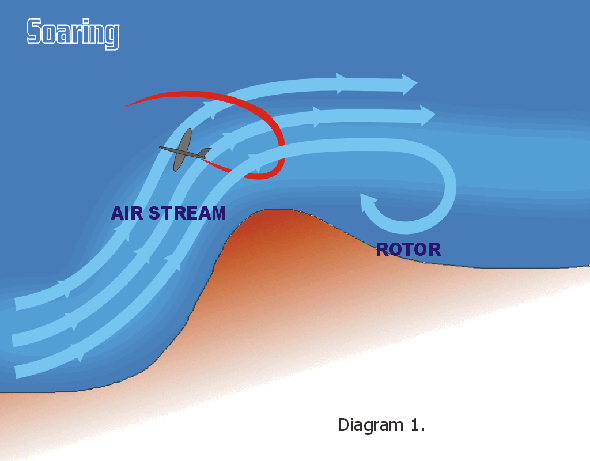
Slope Soaring

Slope soaring radio controlled model planes.
See Also (Dynamic Soaring)
Slope soaring is as old as life on earth. Animals have been using the updrafts from hills and trees for billions of years. This rising current of air lifts certain shaped object up with it, as it goes. We usually call such objects aerodynamic, but there is a lot more to the term, than most presume. Birds, bats and insects are the natural gliding aeronauts, they have very different shapes but are all aerodynamic. Sea birds soar the cliffs of most of the coastlines of the world, as well as the ocean waves. They are so far beyond our technology we may never catch up to their skills and senses. They all seem to love flying and with the right glider you can too.
Slope soaring gliders are many and varied, mostly they have no engine and no propulsion. The air provides propulsion and radio controlled servo motors help to control the aircraft, keeping it in the lift band. This control arrangement usually denotes the kinds of aero-models, which are flying-wings (like Fatboy Brat or Fatboy comp) or Elevon-only, Elevator/Ruder craft, Aileron/Elevator and Aileron/Ruder/Elevator. Flying-wings and canard models are usually considered non-conventional aircraft, while planes with tail wings are usually termed conventional.
Radio controlled flying-wings are very popular as slope soarers because they are very maneuverable and great fun to fly. While great fun to fly, flying-wings are relatively inefficient when compared to many conventional aircraft. The wind on most slopes provides an amazing amount of energy, which allows slope soaring models to be fairly inefficient and still fly very well. Flying-wings are also very simple to assemble, which mean more time flying and less time in the workshop. Flying-wings have a very strong geometry which helps prevent damage when they crash (and they all do). Unfortunately, tailless aircraft are not so easy to design as they weight distribution and wing shape are very critical and they are prone to stall on elevator over throw and can yore badly.
Learning to slope soar radio (remote) controlled models is best begun in the local park. You can throw you plane around the park and have a good time learning the controls without loosing you hard earned equipment. Throw the glider into the wind and see how far you can get it to fly. Adjust the trim tabs to get it flying true. You can see how many loops or rolls you can do from a hand launch. Once you are cool at the park stuff you need a hill and not a cliff, to get your first slope soaring experience.
Its important to have the right glider so you don't start behind the eight ball. Fat Bay combat wings are made from a new material called Expanded Poly-propylene (EPP), often called foamies or foam gliders. Combined with glass-fiber reinforced tape and carbon fiber tube framing, EPP models are amazingly tough. These models, if constructed properly, can crash at 60-80 Kph without any damage, excepting for cosmetic marks or scratches. This is why slope soaring wing foamies is becoming so popular. Fat Boy Arc is perfect for your first slope soaring glider or for the experienced pilot.
Soaring is about controlling your glider to do to basic things, keep moving because stationary aircraft go vertical immediately, and keep the model in sight because you can't fly the plane if you can't see it.
This diagram is simple because this is all you really need to know. See the next section for the complications.